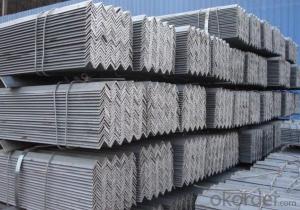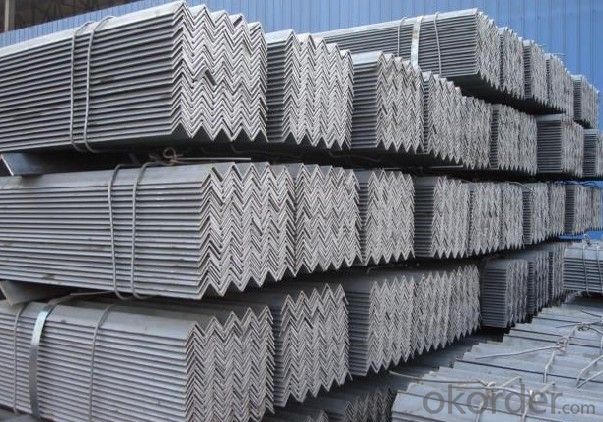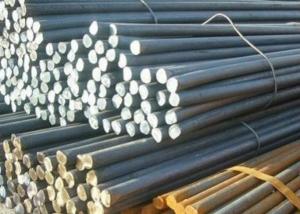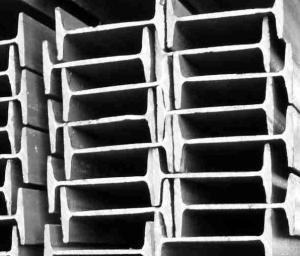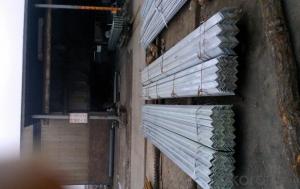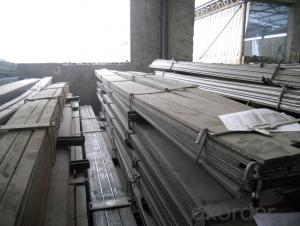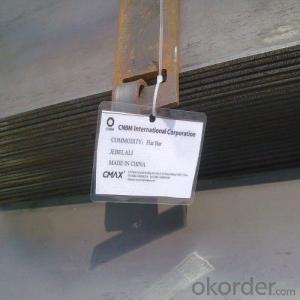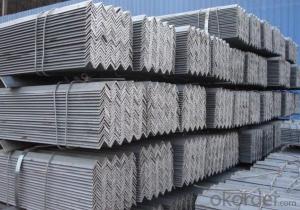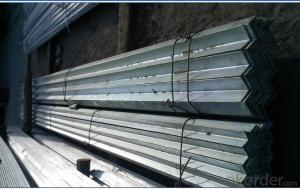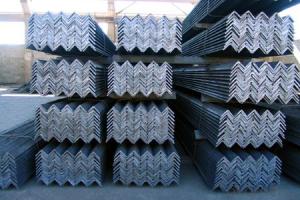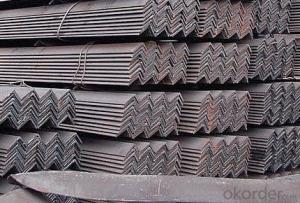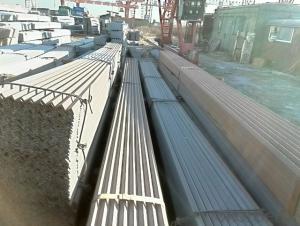Good Quality Angle Steel
- Loading Port:
- China Main Port
- Payment Terms:
- TT OR LC
- Min Order Qty:
- -
- Supply Capability:
- -
OKorder Service Pledge
OKorder Financial Service
You Might Also Like
Specifications
Mild Angle steel
Grade : JIS G3101 SS400,SS540
Size: 25--250mm Brand: TSSC
Payment:L/C or T/T
Packing :bulk or container
Mild Angle steel
Grade : JIS G3101,SS400/SS540
Size: 25*25--250*250mm
Packing : bulk or container
Brand: TSSC
Payment : 100% irrevocable L/C at sight
Delivery time within 60 days .
equal angle steel | unequal angle steel |
specification(mm) | specification(mm) |
25*3/4 | 32*20*3/4 |
30*3/4 | 40*25*3/45*28*3/4 |
40*3/4/5 | 56*36*3/4/5 |
45*3/4/5/6 | 63*40*4/5/6/7 |
50*3/4/5/6 | 70*45*4/5/6/7 |
56*3/4/5/8 | 75*50*5/6/8/10 |
63*4/5/6/8/10 | 80*50*5/6/7/8 |
65*6/7/8/9 | 90*56*5/6/7/8/ |
70*4/5/6/7/8 | 100*63*6/7/8/10 |
75*5/6/7/8/10 | 100*75*6/7/8/9/10/12 |
80*5/6/7/8/10 | 100*80*6/7/8/10 |
90*6/7/8/10/12 | 110*70*6/7/8/10 |
100*6/7/8/10/12/14/16 | 125*75*7/8/9/10/12 |
110*7/8/10/12/14 | 125*80*7/8/10/12 |
120*8/9/10/12 | 140*90*8/10/12/14 |
125*8/10/12/14 | 150*90*9/10/12/15 |
130*9/10/12/13/15 | 150*100*9/12/15 |
140*10/12/14/16 | 160*100*10/12/14/16 |
150*12/15/19 | 180*110*10/12/14/16 |
160*10/12/14/16 | 200*125*12/14/16/18 |
175*12/15 |
|
180*12/14/16/18 |
|
200*14/16/18/20/24 |
|
250*25/35 |
|
- Q: Are steel H-beams resistant to rot or decay?
- Yes, steel H-beams are highly resistant to rot and decay. Unlike organic materials such as wood, which can be susceptible to moisture, insects, and fungal growth, steel is not affected by these factors, making it a durable and long-lasting option for structural applications.
- Q: Are steel H-beams suitable for automotive assembly plants?
- Yes, steel H-beams are suitable for automotive assembly plants. They are commonly used in the construction of industrial buildings, including automotive assembly plants, due to their strength, durability, and ability to withstand heavy loads. Steel H-beams provide structural support, allowing for the creation of large open spaces and efficient assembly line layouts.
- Q: How do you use a steel square to create finger joints?
- To use a steel square to create finger joints, you will need a few essential tools and follow a step-by-step process. Here's how you can do it: 1. Gather the necessary tools: You will need a steel square, a marking knife or pencil, a chisel set, a mallet or hammer, and a workbench or sturdy surface. 2. Prepare the wood: Start by selecting the appropriate wood for your finger joints. Ensure it is flat and free from any defects. Cut the wood pieces to the desired length and width for your project. 3. Mark the wood: Use the steel square to mark the location and width of the finger joints on both pieces of wood. The square will help you create straight and accurate lines. Measure and mark the width of the fingers and the spaces in between. 4. Set the depth: Use the marking knife or pencil to score the marked lines on the wood. This step will help guide your chisel during the cutting process. Make sure the depth of the cuts matches the thickness of the adjoining piece of wood. 5. Chisel out the waste: Place the wood on a workbench or sturdy surface, ensuring it is secured in place. Use the chisel and mallet or hammer to carefully remove the waste wood between the scored lines. Start by making shallow cuts along the marked lines and gradually deepen the cuts until the waste is removed. 6. Test the fit: Once you have completed the cuts on one piece of wood, test the fit by inserting the fingers into the corresponding spaces of the adjoining wood piece. The joints should fit snugly without any gaps or looseness. If needed, make any necessary adjustments using the chisel until you achieve a perfect fit. 7. Glue and assemble: Apply a thin layer of wood glue to the joints and press the pieces together. Use clamps or other securing methods to hold the joint in place while the glue dries. Follow the manufacturer's instructions for the recommended drying time. 8. Final touches: Once the glue has dried, use sandpaper or a file to smooth out any rough edges or imperfections in the joint. This step will ensure a clean and professional finish. By following these steps and using a steel square as a guide, you can create precise and strong finger joints in your woodworking projects. Remember to practice caution and work slowly and carefully to achieve the best results.
- Q: How many roots are there in a standard ton of steel and how many meters are there in a steel bar?
- The general drawing bar is 6 meters, some ribbed bars 9 meters and 12 meters two tons of steel; a number of roots can not say, can be 1 or 100 roots, the length of thickness do not know how to tell you how many tons of reinforced root ah.
- Q: What are the maximum allowable deflections for steel angles?
- The maximum allowable deflections for steel angles depend on various factors such as the type of angle used, the material properties, the loading conditions, and the design codes and standards being followed. In general, the deflection limits are determined to ensure the structural integrity and functionality of the steel angles. Excessive deflections can cause structural instability, reduced load-carrying capacity, and potential failure of the angles. Design codes and standards such as the American Institute of Steel Construction (AISC) specify deflection criteria for different applications. For example, the AISC 360-16 specification provides deflection limits based on the span length and the serviceability requirements of the specific structure. The allowable deflections for steel angles are usually expressed as a fraction of the unsupported span length. Typical deflection limits for steel angles range from 1/240 to 1/360 of the span length, depending on the specific application and loading conditions. It is important to note that these deflection limits are guidelines and should be assessed in conjunction with other design considerations such as strength, stability, and dynamic effects. Additionally, consulting the applicable design codes and standards, as well as seeking professional engineering advice, is crucial to determine the precise maximum allowable deflections for steel angles in a given project.
- Q: What are the different surface finishes for stainless steel round bars?
- Different surface finishes can be applied to stainless steel round bars depending on the desired aesthetic appeal and functional needs. Some common surface finishes for stainless steel round bars include the following: 1. Bright Annealed (BA): This finish is achieved by annealing the stainless steel round bar in a controlled atmosphere, resulting in a smooth and highly reflective surface. It is often used for decorative purposes due to its mirror-like appearance. 2. Mill Finish: Also known as hot rolled or hot-rolled annealed and pickled (HRAP), this surface finish is the untreated surface directly from the mill. It has a rough and pitted texture, making it suitable for industrial applications where appearance is not the main concern. 3. Satin Finish: Also referred to as brushed or dull polished finish, this surface finish is achieved by brushing the stainless steel round bar with a fine abrasive material. It creates a soft and matte appearance with visible parallel lines. 4. Polished Finish: This finish is achieved by progressively using finer abrasive materials to polish the surface of the stainless steel round bar. It results in a high-gloss, mirror-like finish that is commonly used for decorative purposes. 5. Ground Finish: This surface finish is achieved by grinding the surface of the stainless steel round bar using abrasive belts or wheels. It creates a uniform and smooth surface with a matte appearance. 6. Bead Blasted Finish: This finish is achieved by bombarding the surface of the stainless steel round bar with small glass beads at high pressure. It creates a uniform and matte appearance with a slightly textured feel. 7. Electropolished Finish: This finish is achieved by immersing the stainless steel round bar in an electrolytic bath and applying an electric current. It removes a thin layer of material, resulting in a smooth and shiny surface with improved corrosion resistance. Each surface finish possesses its own distinct characteristics and is selected based on the specific requirements of the application.
- Q: What is the weight-bearing capacity of steel I-beams?
- The weight-bearing capacity of steel I-beams can vary depending on a few factors such as the size and shape of the beam, the type of steel used, and the span or distance between supports. Generally, steel I-beams are known for their high strength-to-weight ratio and can support significant loads. To determine the weight-bearing capacity of a specific steel I-beam, engineers and architects often refer to structural design codes and calculations. These codes provide guidelines and formulas for calculating the maximum load a beam can safely withstand without experiencing excessive deflection or failure. For example, in the United States, the American Institute of Steel Construction (AISC) provides design standards and specifications for steel structures. The AISC Manual of Steel Construction contains comprehensive tables and charts that allow engineers to determine the load capacity of different beam sizes and configurations. In addition to the design codes, other factors such as the type of loading (e.g., dead loads, live loads, or dynamic loads) and the support conditions (e.g., simply supported or continuous) also influence the weight-bearing capacity of steel I-beams. Therefore, it is essential to consult the appropriate design codes and work with a qualified structural engineer or professional to accurately determine the weight-bearing capacity of steel I-beams for a specific application.
- Q: Can steel angles be used for load-bearing walls?
- Load-bearing walls can indeed utilize steel angles. In construction, steel angles serve as a structural component, offering support and stability. They effectively reinforce load-bearing walls, enhancing their strength and rigidity. By evenly distributing the weight of a load, steel angles are well-suited for load-bearing purposes. Nevertheless, it is crucial to ensure that the design and installation of the steel angles align with the wall's specific load criteria. Seeking guidance from a structural engineer or construction expert is advisable to guarantee the correct application of steel angles for load-bearing walls.
- Q: What are the different methods of reinforcing steel I-beams?
- To enhance the strength and durability of steel I-beams, there are several methods for reinforcement. These methods are as follows: 1. Additional steel plates can be welded onto the flanges or webs of the I-beam. By doing so, the cross-sectional area and overall strength of the beam are increased. 2. Steel angles or channels can be attached to the sides of the I-beam, creating a composite section. This adds stiffness and stability to the beam. 3. In some cases, steel plates with strategically placed holes are used to reinforce I-beams. These plates are either bolted or welded to the beam, forming a composite structure that can better withstand bending and shear forces. 4. Carbon fiber reinforced polymer (CFRP) wraps offer excellent tensile strength and stiffness. These wraps consist of layers of carbon fiber sheets bonded to the surface of the I-beam using epoxy resin. They are particularly beneficial for strengthening beams under high loads. 5. Steel rods or bars can be inserted through the web of the I-beam and secured with anchor plates or couplers. This method, known as through-rod reinforcement, helps redistribute loads and prevents shear failure. 6. Another approach involves creating a composite beam by bonding a steel plate to the bottom of the I-beam. This increases the section's resistance to bending and allows for greater load-carrying capacity. It is essential to consider various factors such as the type and severity of the loading, available space, and project requirements when choosing a reinforcement method. Consulting professional structural engineers and designers is advisable to determine the most suitable reinforcement method for a specific application.
- Q: Can steel round bars be used in the manufacturing of tools and equipment?
- Yes, steel round bars can be used in the manufacturing of tools and equipment. Steel is a strong and durable material that can withstand heavy loads and provide stability. Round bars can be shaped, cut, and machined into various tool components such as shafts, handles, or blades, making them suitable for a wide range of applications in the manufacturing industry.
Send your message to us
Good Quality Angle Steel
- Loading Port:
- China Main Port
- Payment Terms:
- TT OR LC
- Min Order Qty:
- -
- Supply Capability:
- -
OKorder Service Pledge
OKorder Financial Service
Similar products
Hot products
Hot Searches
Related keywords
